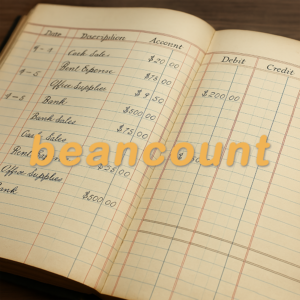 Beancount is a neat FOSS project with a simple concept: full double-entry accounting from the command line.
Beancount is a neat FOSS project with a simple concept: full double-entry accounting from the command line.
Originally developed by Martin Blais, Beancount is a double-entry accounting system that stores your data in plain text, uses your favorite text editor, and integrates well with Unix-style workflows. No bloated GUI, no SaaS lock-in—just clean, transparent accounting with powerful reporting.
Now granted, I probably wouldn’t use it to manage General Motors’ finances…but in theory you could. All modern accounting is done using a system designed in the 15th century in Italy. It’s conceptually pretty simple. I’m not going to teach you bookkeeping here, but let’s take a look at this cool project.
Beancount Bullet Points
Beancount follows the philosophy of simplicity:
- Plain text accounting: Your ledger is just a .beancount file, which is plain text.
- Command-line native: Perfect for SSH servers, VPS environments, or your local terminal.
- Auditable: Easy to track changes with version control systems like Git.
- Flexible: Works for personal finance, small business bookkeeping, crypto, stock investments, and more.
- Fast: Processes thousands of transactions quickly. Each operation is just an update to a text file.
Example Transaction
A simple transaction might look like this:
2025-04-05 * "Coffee at Local Cafe"
Expenses:Food:Coffee $4.50
Assets:CashThis records a $4.50 expense. In accounting language, you’re recording a debit from an asset (cash), and a credit to an expense (in this case, an expense account which is categorized/sub-categorized as Food, Coffee).
Every account is a simple text line, and you categorize as you go. Beancount also supports:
- Multiple currencies
- Commodity tracking (great for crypto)
- Price declarations
- Automated reporting
- Balance assertions
- Querying via its own powerful tool, bean-query
Quick Start with Beancount
Let’s get you up and running.
1. Install Beancount
If you’ve got Python 3, just run:
pip install beancountOr clone from GitHub for the latest version:
git clone https://github.com/beancount/beancount.git
cd beancount
pip install .2. Create Your First Ledger File
Make a file called example.beancount:
option "title" "My Personal Ledger"
option "operating_currency" "USD"
2025-04-05 open Assets:Bank:Checking USD
2025-04-05 open Expenses:Food USD
2025-04-05 * "Initial deposit"
Assets:Bank:Checking $1000.00
Equity:Opening-Balances
2025-04-05 * "Groceries"
Expenses:Food:Groceries $120.00
Assets:Bank:Checking3. Check the Ledger
Run the Beancount checker:
bean-check example.beancountNo errors? You’re good to go!
4. Generate Reports
Beancount integrates with web interfaces like Fava:
pip install fava
fava example.beancountThis spins up a web dashboard for your ledger at http://localhost:5000.
5. Run Queries
You can run SQL-like queries on your data:
bean-query example.beancount "SELECT account, sum(position) WHERE account ~ 'Expenses' GROUP BY account"Final Thoughts
Beancount is a simple idea, well-implemented. Because of its simple interface, you can easily script entries, and since the “database” is just a text file, it’s a cinch to edit or extend with your own tools and reports.
Now all we need is a WHMCS module…























Leave a Reply